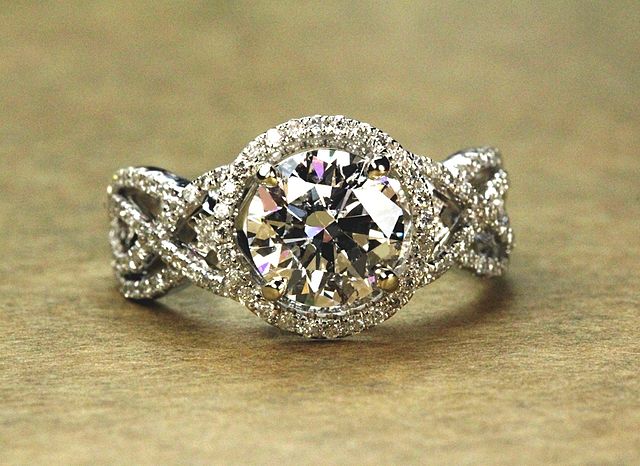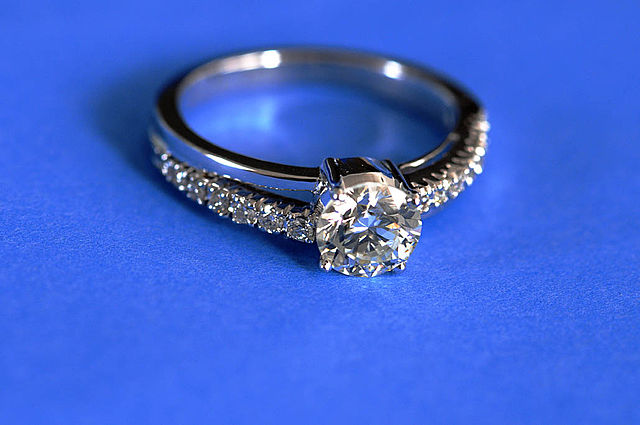You’ll want the perfect engagement ring regardless of whether you’re a man getting ready to pop the question or a lady hoping to be in control of their dream wedding.
Either way, the engagement ring must be just right for the recipient, as it will be something that will be worn for the rest of their life. To ensure it’s a visual token of a couple’s love and dedication, follow this guide put together by Lycetts:
Choosing a setting
You will need to determine the ‘setting’ the engagement ring has. This denotes the way the diamond or gemstone is actually fixed to the ring and will change the overall appearance quite heavily. The most common are:
- Prong: This refers to a small metal claw that grips the diamond or stone to hold it in place. These prongs can be rounded, pointed, flat of even V-shaped. Commonly they have four prongs, which allows plenty of light to pass through the diamond. However, prong settings can sometimes snap, making engagement ring insurance
- The Cathedral: This is a popular variant of prong setting that involves setting the diamond quite high, which increases the risk of snagging.
- Tiffany: This is a trademarked six-prong style that is often imitated by others.
- Bezel: The bezel setting is a modern look, encircling the diamond with a thin overlapping rim. You can get these in full or partial bezels and they’re a good choice for active people as they’re durable and don’t snag.
- Tension: This refers to rings which hold the diamond by tension, giving the appearance of the gemstone floating between the metal. Often, many tension-style bands use a prong or bezel under the diamond to firmly anchor it.
- Channel: This is when you set diamonds into the ‘channel’ of the band, often tightly together.
- Pavé: From the French word ‘to pave’ this setting refers to a ring ‘paved’ with diamonds that have tiny beads or prongs holding them in place.
- Halo: Refers to small diamonds set in a circular pattern that repeats across the surface to create the ‘halo.’
Picking a stone
Now that you have the setting picked out, it’s time to choose the stone. The classic diamond is the most common thanks to its brilliant lustre and shine. When you go to select one, you’ll need to decide on the carat, clarity, colour and shape.
Often, the carat of the diamond can be anything from .1 to a full 1 carat stone. However, as a luxury purchase, diamonds can vary wildly in size up to 100 carats, worth millions. They refer to the weight of the stone and you can often net discount if the stone is slightly under popular weights such as 1/2ct, ¾ ct and 1ct. Sometimes, the diameter of the stone is different to the weight and a lesser carat can look as large as a full carat.
There will also be the option of selecting between gems with different clarity grades if you choose to order your engagement ring from a bespoke company. Obviously, you should buy the best clarity you can afford to ensure the diamond is as shiny as they’d expect. The colour isn’t too important, as the untrained eye will hardly notice differences – especially once it’s set in a ring that will give its colour to the gem.
Shape of the diamond
In terms of a diamond’s shape, you have all of the following options:
- Round: The most popular shape, this simple style makes up 75% of all diamonds sold. It maximises brightness due to its reflective properties.
- Princess cut: a fancy shape that screams elegance.
- Oval: An elongated shape that helps create the illusion of greater size.
- Marquise: A football-shaped, brilliant-cut diamond that creates the largest surface area of any diamond.
- Pear: Pear-shaped diamonds combine marquise and round shapes to create good symmetry.
- Cushion: A cushion diamond is a square cut that has rounded corners and is one of the most popular shapes.
- Emerald cut: a large, flat-faced diamond that creates a hall of mirrors effect.
- Radiant cut: similar to an emerald cut, but modified to have a vibrant, lively face with brilliant-cut design.
- Heart-shaped: say you love them with an iconic symbol.
Selecting the band materials
There are three main choices and a few more ‘outsider’ picks available to you when it comes to choosing the band material of your engagement ring. These are as follows:
- Gold: The classic wedding ring style, a gold band comes in various carats. The measurement indicates the purity of the gold and is in ascending increments between 9,14,18,22 and 24 carats. 22 is the purest form for jewellery.
- Silver: A long-standing precious metal that is beautiful in its simplicity, silver is nonetheless prone to tarnishing, so should be coated or protected.
- Platinum: Platinum gives a ring a bright white-silver look that is far shinier than other materials. It is a high-density metal that is ultra-durable. It is naturally hypoallergenic and carries lifelong hardiness. Of all the ‘silver’ bands, it is platinum that carries the most prestige.
- Palladium: A chemical that is softer and more affordable than platinum, palladium is naturally hypoallergenic and develops a patina over time. It is an ideal substitute for white gold or platinum.
- White Gold: White gold follows the same principles as gold, but is alloyed with precious white metals like silver or palladium to give it a beautiful, eye-catching polish and shine. The use of palladium makes the ring slightly more expensive compared to standard ‘yellow’ gold. The finish complements and enhances the shine of the diamond.
A note about the engagement ring’s price
Finally, on the matter of deciding how much to spend on an engagement ring, it is recommended that you go towards the higher end of what you can afford. Don’t put yourself in crippling debt to get one by all means – but spending a decent amount of money illustrates your commitment. The age-old rule of three month’s salary is long dead, as you can get an eye-catching ring affordably. However, they’re going to wear it for the rest of their life, so spend as much as you can comfortably manage and see their eyes light up.


